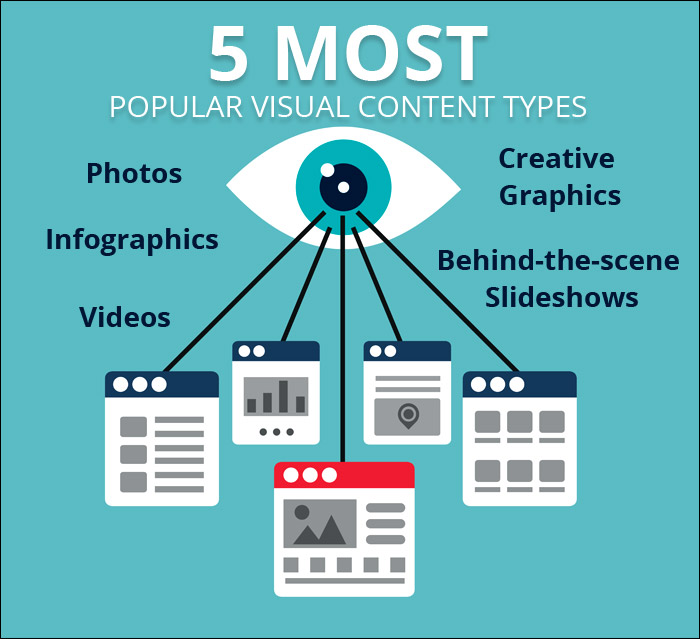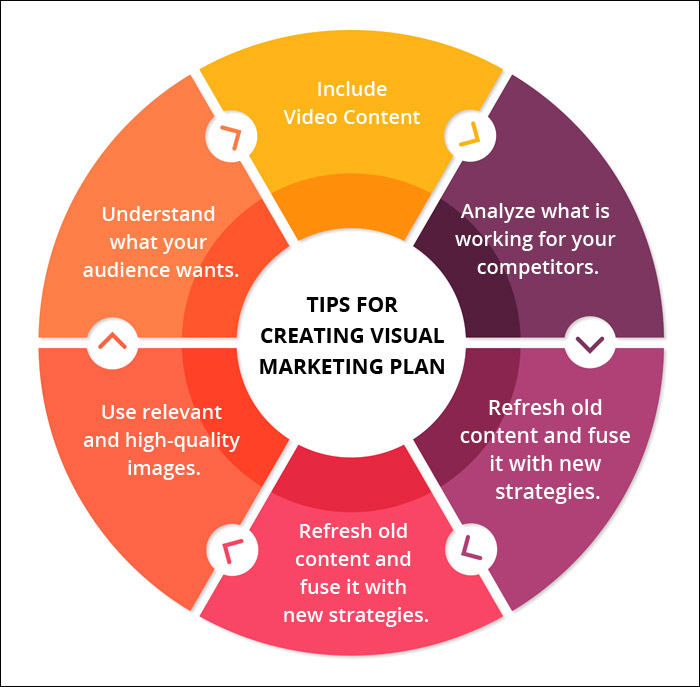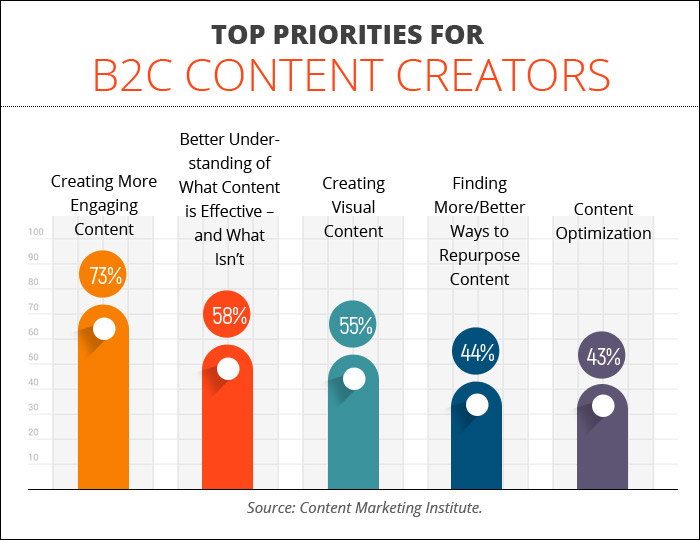5 Reasons Your Medical Practice Needs a Visual Marketing Plan
Posted on
To start with, here are the key stats you must know about the importance of including visual content in your healthcare marketing plan in 2018:
- Nearly 37 percent of marketers said visual marketing was important for their business, second only to blogging (38%). (Source: Social Media Examiner)
- Four times as many customers would rather watch a video about a product than reading about it. (Source: Animoto)
- Eye-tracking studies show that Internet users pay more attention to information-carrying images. When the visual graphics are relevant, readers spend more time on the web page looking at the images than reading plain text. (Source: Nielsen Norman Group)
- Studies show our brain not only processes visual content faster, but it also retains and transmits information faster when it is delivered visually.
- Tweets with graphics and visuals receive 18 percent more clicks, 89 percent more favorites and 150 percent more retweets than plain text tweets. (Source: Buffer)
One healthcare marketing trend that is impossible to ignore is the growing influence and power of visual content. Just look at the fastest-growing social media networks: Facebook, Pinterest, Instagram and Snapchat.
The way Internet users — especially millennials — are consuming online content is radically changing. If what an average human consumes in just one minute online tells a fact, people are engaging with, connecting to, searching for, watching and downloading visual content more than ever. As a healthcare marketer, it is critical to adapt your marketing plan to maintain a competitive edge.

Visual content increases brand recognition, awareness and engagement. It also enhances the overall impact of your healthcare marketing plan by effectively communicate your message to your target audience. Visual content such as pictures, infographics, illustrations and videos are some of the most effective forms of content that are having a huge impact on the way patients consume healthcare information. Most of your visual assets will continue to grow in importance over the next few years.

Another reason that makes visual content more appealing is that most people have an innate psychological resonance with visual content. According to a report, nearly 54 percent of people prefer to receive useful information in the form of videos instead of email newsletters or social media posts. In addition, information that is presented using effective visuals and graphics is more memorable than plain text-based content. With visuals, you can convey emotions that are not possible with plain text. Human emotions usually lead to action, and action usually leads to conversions. This is why landing pages with attractive visuals convert 80 percent better than those without visual content.
Visual content is gaining an important place in the healthcare marketing plans of most medical practices, regardless of their size, specialty and location. Most healthcare marketers use innovative forms of visual content to connect with their existing and potential patients, engage with them and convert prospects into loyal patients. According to a study, using the word “video” in the subject line of your email can increase click-through rates by 65 percent, increase open rates by 19 percent and reduce un-subscribers by more than 26 percent.
Brand building and visual content go hand in hand. If you are looking to improve your brand image and want to be recognized as a thought leader in your niche, you need to create persuasive content that resonates with your target audience. Your content should tell your story and maximize your online outreach. However, with hundreds and thousands of medical practices spawning every single day, it gets harder to cut through the noise and convey your message to the target audience. According to healthcare marketing experts, 2018 is the year when individual medical practices and larger healthcare facilities should explore newer content types to acquire new patients and improve their online reputation.
How Does Visual Marketing Work?
Digital healthcare marketing relies on strategies. Many healthcare marketers are turning toward visual marketing as a means to convey messages to their target audience. Whether you are writing blog posts to attract more patients to your practice or you are optimizing your website to improve conversion rates, it is important to sit down and think about how to move forward. Industry experts recommend including visual elements as part of your new healthcare marketing campaigns.
The idea of visual marketing is that it stops readers from skipping past you on social media or a blog post that you have shared. The beauty of visual marketing is that it allows you to break down complex information and help readers digest more information through your visual elements.

One of the most effective forms of visual content is video. According to a study, video reaches three times as many people and gets 20 percent more attention than standard text blog posts. Video engages your target audience and guides them through the patient journey like no other medium can. Your video content can help nurture relationships and help you stay top-of-mind with potential patients.
Visual marketing is an effective way to build brand awareness because the majority of people are turning to online content for entertainment and education. Visual content provides opportunities for creativity and versatility, and if done right, it does not eat into your marketing budget. With effective visual content, your can improve conversion rates, increase patient outreach and improve patient engagement levels.

Benefits of Visual Marketing
Are you launching a new product or service? Are you looking to launch an effective digital marketing campaign that gives your medical practice the attention it deserves? If yes, then turn to visual marketing. Nearly 71 percent of marketers agree that visuals outperform any other form of marketing content. This is why 45 percent of businesses have an explainer video on their landing page, and 83 percent of those businesses feel their explainer videos are effective.
Emotionally charged and creative visual content can spread on the Internet like wildfire, getting millions of views within a few days. A well-made and effective visual or graphic can become your best patient acquisition and marketing tool.

Undoubtedly, visual marketing is one of the newest additions to your healthcare marketing toolbox. Here are some of the key reasons why you should consider visual marketing to market your practice:
1. Attracts your audience’s attention: Visuals can speak a thousand words and engage your audience more effectively. The current fast-paced, digitally powered world leaves us with shorter attention spans. By integrating visuals with plain content, you can help your target audience absorb more information and keep their attention longer. Studies prove that people retain 65 percent of information after three days when the plain text is combined with visuals. Stimulating your target audience’s imaginations will heighten their creative thinking, allowing for a more profound understanding and retention of your marketing message.
2. Gets more followers: Sharing effective visuals generates more traffic and responses and reaches a greater audience. By sharing more visuals, your target audience can easily share, like and respond to them for greater impact. In addition, visual content on social networks is 40 times more likely to be shared than any other form of content. According to the Social Media Marketing Industry Report, 60 percent of social marketers used video content in 2015. The latest features on social networks encourage sharing of video content. However, on social networks, people are more interested in sharing emotions, not facts. Though emotions cannot directly increase your ROI, social shares can drive more targeted traffic to your website.
3. Increases ROI and conversions: In order to get you more excited, 83 percent of businesses say visual content provides a good return on investment. Creating good-quality visuals is not a simple task, but the gains are significant. For instance, adding a video on your website can increase conversion rates by almost 80 percent. Video can also lead directly to appointments. According to a study, 74 percent of viewers who watched a product video subsequently bought it.
4. Builds trust: Trust is the foundation any medical practice. Visual content is likely to engage users and ignite emotions. For instance, some people are skeptical about trying a new healthcare provider. But effective visual marketing can present your practice and services in a conversational form. This is why 57 percent of users feel videos about a business or services make them more confident.

5. Google prefers visual content: Videos increase the time spent by visitors on your website, which signals search engines that your website has relevant content. According to Moovly, a company is 53 times more likely show up on the first two pages of Google if it has a video embedded on its website. However, be sure to optimize your videos for SEO.
Types of Visual Content
Here are four types of visuals that will take your healthcare marketing to the next level:
1. Product demonstrations: Product videos allow your existing and potential patients to see your products and services at their own convenience, without relying on your staff members to walk them through the process. Including videos on your product page will increase visitors’ time on that page, which may increase the likelihood that they might convert. Product videos will highlight your products’ features and benefits while effectively engaging your target audience. These videos are particularly beneficial for prospects who are in the awareness stages of the buyer’s journey and looking for a comprehensive explanation of your services. You can also consider including product update videos on your practice website. These videos can keep your patients updated about the latest changes to your service offerings. In addition, product update videos can educate your target audience and help increase product adoption.

2. Patient testimonials: This is one of the quickest and easiest forms of visuals to produce. It is also one of the most powerful because there is no better salesperson for your practice than a satisfied patient. Most potential patients do not trust testimonials written on a third-party website because there is no way of ensuring if the comments are genuine. However, a video is quite convincing. Video testimonials will not only tell a success story but will also empower happy patients to share their stories in their own words. This will create a much more powerful message for both marketing and conversion purposes. Patient testimonial videos can play an integral role in attracting new patients.
3. Educational video: Explainer or educational videos are an excellent way of introducing your practice to potential patients and explaining your services. These videos are simple and easy to follow, pointing out how you address your patients’ health issues. Explainer videos can increase your conversions by almost 20 percent, so consider adding one to your landing pages. By the end of your explainer video, your viewers should be ready to take the desired action based on the information they have learned in your video. While product videos will ultimately be replaced by updated videos, educational videos will provide value for a long time.
4. Behind-the-scenes pictures or video: These pictures or videos can give you the opportunity to interact with your target audience by telling them your story. Behind-the-scenes images allow your target audience to become familiar with your practice and the unique value it offers. Sharing these visuals is particularly important for individual practices because they have the potential to increase patient awareness and highlight the unique services that set your brand apart from competitors. One of the best ways to make your practice seem more trustworthy is to share visuals that provide a glimpse of your values and culture.
Final Word
With online visual content becoming a key means for people to satisfy their information needs, medical practices that fail to include visuals in their marketing campaigns will do so at their peril. Visuals are the future of healthcare marketing. According to Nielsen, almost 64 percent of marketers are expecting visuals, especially video content, to dominate their online strategies shortly.
When it comes to potential reach, visual content is incomparable. For instance, YouTube attracts more than 1 billion unique visitors every month, which is more than any other social network, except Facebook. Video can give you access to a vast community of online video viewers. Engage your viewers and they will not only share your visuals with others but also spend more quality time on your website. For social media marketing, SEO campaigns and online marketing strategies, visuals are the best tools in your arsenal. Now think this: If your target audience is reacting favorably to your plain text, imagine how they will react if you combine text with attractive visuals. The conversions will be as good as their reaction.
At Practice Builders, our experts can help you create an effective visual marketing strategy for your medical practice. For a complimentary assessment of your current medical practice marketing strategy, please get in touch with us.

 Why Good communication Matters in Healthcare
Why Good communication Matters in Healthcare De-Escalation Tips for Handling Aggressive Patient..
De-Escalation Tips for Handling Aggressive Patient.. Reaching The Right Audience Through Target Marketi..
Reaching The Right Audience Through Target Marketi..